Entries in wind lease (7)
12/24/11 UPDATED: Before you sign on with a wind developer: some legal advice AND Money doesn't always talk: More farmers saying no to wind developers
WINDS OF CHANGE: WIND LEASE CONSIDERATIONS
Author(s): Robert S. "Sam" Arthur, Jr., Justin H. Boyd
Published: 12/22/2011
Beware of a wind developer who attempts to include unnecessarily long evaluation periods or free extensions, as such lessee may be attempting to stockpile potential wind sites, without any intent to develop and with the hope of assigning the leases to larger wind developers.
Colorado has become a leader in the wind energy industry. According to the American Wind Energy Association, our state is the third-highest wind energy generator in the United States. Farmers, ranchers, and other landowners should consider if their property is suitable for wind energy development and how such development could be integrated into the current uses of their land. Some major factors that impact the decision to enter into a wind lease are discussed in this article.
Power in Numbers
Owners of land in areas that are advantageous for wind farm development should consider joining forces. Increasing the acreage available for wind farm development will increase the landowners' leverage when negotiating with a wind developer. Landowners in high wind-speed areas may wish to collectively engage an environmental consultant to determine the suitability of their land for wind development.
Factors that may increase the value of the lease opportunities include proximity to transmission lines, local and state economic incentives, and the approval process of the local regulatory authority. Factors sometimes found in Colorado, which may decrease the suitability for wind development, include rocky or mountainous terrain and close proximity to federally protected lands. If neighbors join forces, in addition to enhancing their bargaining power, the evaluation costs can be spread among the collective group.
The Four Stages of Wind Development That Must Be Addressed in the Lease
Evaluation Stage – During this period, the wind developer studies the feasibility of the site for constructing wind turbines, evaluates environmental issues, determines the permitting process, and obtains the necessary financing. While the duration of this stage will vary, the landowner should attempt to limit this stage to a period that lasts no longer than three years. In addition, during this time the wind developer should be paying a guaranteed monthly or annual rent payment. Beware of a wind developer who attempts to include unnecessarily long evaluation periods or free extensions, as such lessee may be attempting to stockpile potential wind sites, without any intent to develop and with the hope of assigning the leases to larger wind developers.
Construction Stage – Assuming that the wind developer desires to proceed from the evaluation stage, the construction of the wind turbines will begin. The landowner should negotiate for a construction bonus that reflects the value of the site and also may be based on the number of turbines constructed. The wind developer should continue to pay the monthly or annual rent during this stage.
Operational Stage – Once the equipment has been installed, wind energy is produced and sold for profit to available markets. Generally, the landowner will receive a royalty or percentage of gross revenues received from the production of the wind energy. The landowner should negotiate the percentage of gross revenues that it receives to be increased every five or so years of the lease. While the percentage will vary from location to location, the landowner should be suspicious of any proposed royalty of 3 percent or less of gross revenues during the beginning period of the operational stage. Operations of the wind turbines can last anywhere from fifteen to fifty years.
Termination Stage – If the wind developer terminates the lease prior to even reaching the construction stage, the landowner should negotiate for a termination fee. Otherwise, the wind developer will have encumbered the landowner's property for the relatively low price of the monthly or annual rent, when the landowner could have been negotiating with another wind developer with the means to actually construct and operate the wind turbines. Assuming that the wind developer does complete the operation stage, the lease will provide for the wind developer to "decommission" the wind turbines. The landowner should receive some type of security, in the form of a bond or cash security deposit, to assure that the wind developer has an economic incentive to properly remove its equipment. The landowner should ensure that the wind developer removes its wind turbines and other equipment in an efficient manner, and leaves the land in a condition no worse than when the wind developer commenced construction.
Beware of the Landowners' Indemnifications
As with many legal agreements, parties often agree to mutually indemnify the other for any damage caused by their own acts or negligence. For example, if the wind developer breaks the farmer's fence or irrigation structures when installing its large equipment, the wind developer will fix and replace the damage; such repair or replacement costs could run into thousands of dollars. Conversely, imagine if the farmer's tractor runs into the wind turbine, which costs millions of dollars to replace. Such type of damage could force many farmers into bankruptcy. As a result, the landowner may wish to negotiate a maximum limit to its indemnification obligations, to account for the parties' potential economic risks.
Location of Wind Development, Reserved Uses, and Prohibited Uses
The landowner should expressly require the wind developer to refrain from development on or use of specific portions of the land if the circumstances dictate. For example, the landowner may prohibit the wind developer from operating within 500 feet of a residence or within 25 feet of either side of a river or a creek that runs through the property. Most importantly, the lease should expressly reserve to the landowner the right to use his or her property for other uses, such as grazing, hunting, fishing, mineral exploration, or solar energy. In addition, the landowner may desire to reasonably restrict the access rights of the wind developer so as not to disrupt the landowner's peaceful enjoyment.
Taxes and Utilities
Upon construction of the turbines, the value of the property will increase. As a result, the county assessor likely will increase the property taxes assessed to the property. In addition, the utility costs on the property to operate the turbines will rise dramatically. The landowner should ensure that these increased costs incurred by the wind developer are passed on to the wind developer.
Assignment
As mentioned previously, some wind developers desire to obtain numerous wind leases without ever intending to construct or operate wind turbines. Instead, their hope is to assign these wind leases to larger wind developers. As advised above, landowners should work with their neighbors and join forces to cut out this type of middleman, and they should attempt to present their own attractive opportunity to a large wind developer. As another protection, the individual landowner also should restrict the ability to assign the lease. At a minimum, the landowner should have some type of "reasonableness" standard in being required to consent to such assignment to ensure that the assignee has the same economic capacity to both construct and operate the wind development.
The above are just some of the major factors that landowners should consider before entering into a lease with a wind developer. The wind lease may provide attractive economic security; however, given the long duration of these agreements, the landowners must ensure that their interests are protected. If you have any questions regarding wind-lease issues, please do not hesitate to contact Sam Arthur or Justin Boyd.
From Illinois
NO WELCOMING COMMITTEE FOR WIND FARMS: HAMILTON TOWNSIP AMONG COMMUNITIES IN OPPOSITION
BY DAVID GIULIANI,
December 23, 2011
“They wanted us to sign a 70-year contract,” Gonigam said. “That would affect my kids, grandchildren and great-grandchildren.”
WALNUT – Stacy Gonigam’s family decided against having wind turbines on their farm in southwestern Lee County.
Ireland-based Mainstream Renewable Power approached the family for its Green River wind farm, which is planned for Lee, Whiteside and Bureau counties.
Gonigam said she didn’t sign a contract with Mainstream because it would bind her family for a long time.
“They wanted us to sign a 70-year contract,” Gonigam said. “That would affect my kids, grandchildren and great-grandchildren.”
Gonigam also is the supervisor for Hamilton Township, population 236.
During the past summer, the township board voted unanimously for a comprehensive plan that recommended against the construction of wind turbines.
The township is not alone in its opposition. In the spring, the village board in Whiteside County’s Deer Grove, population 48, voted unanimously to regulate turbines within 1.5 miles of its boundaries. That was in response to news of Mainstream’s plans.
Now that Deer Grove has passed a zoning ordinance, the village has the right to ban wind farms in the areas near its borders, county officials say. Opposition to Mainstream’s proposal is strong in Deer Grove, so it’s doubtful the board will approve construction of turbines nearby.
While Hamilton Township’s comprehensive plan isn’t binding, it’s a statement against turbines, Gonigam said.
Sandy Cruse, a lifelong resident of Hamilton Township, said her survey found that 80 percent opposed wind turbines.
“Our area is recovered swampland,” said Cruse, whose family has a farm. “We’re 90 percent flood plain. It’s all supported by good drainage.
“We are stewards of the land, and we want to be good stewards. We’re all agricultural, and that’s what we would like to see.”
She feared that a wind farm would affect the drainage. She also said she and others don’t want the noise and shadow flicker associated with turbines.
Mainstream officials have pledged to be good neighbors, saying they want to reach out to residents.
Mainstream plans to put in 60 to 90 turbines in the first phase, the vast majority of which would be in Lee County. The second phase would include a similar number, officials say.
Last month, Whiteside County finished its review of its wind energy regulations. Officials decided against making changes.
Mainstream was expected to turn in its application to Whiteside County soon after that. But the company has yet to do so.
John Martin of Mainstream said his company is working on the application and expects to complete it soon.
The Lee County Zoning Board of Appeals has been meeting since the summer; it has recommended many changes to the existing ordinance.
On Thursday, the board will debate perhaps the biggest issue of all – the required distance between turbines and houses.
That should be the last major item of business.
The board’s recommendations will go to the full Lee County Board, which has the final say.
11/21/11 Fragmented farmfields in WeEnergies new wind project AND How do you UN-sign on the dotted line? Farmers want out of wind developer's contracts
The photos below were taken by Jim Bembinster. They show how farmfields have been fragmented by wind turbines and access roads in WeEnergie's Columbia County wind project. What they don't show is the compaction of the soil from heavy machinery. Compacted soil affects crop production. Contracts signed by farmers in this project gives WeEnergies the right to site the turbines as they see fit.
CLICK HERE To read about a farmer whose land was leased to WeEnergies for this project and what has happened to his life and his farm since then.
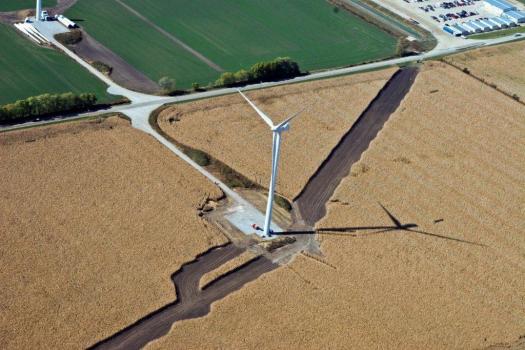
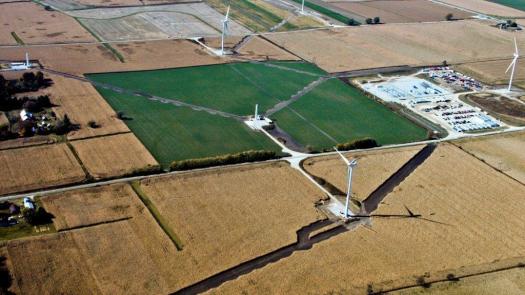
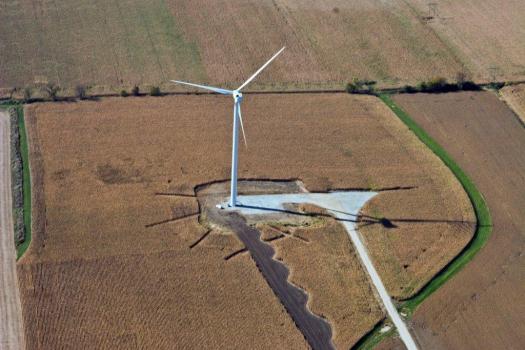
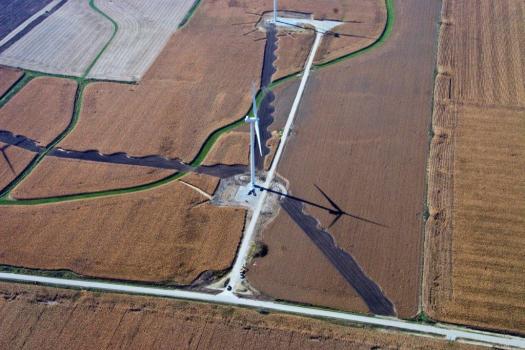
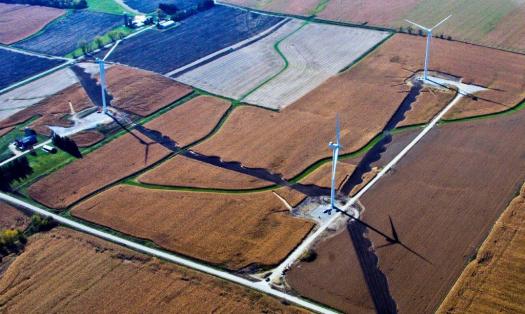
From Minnesota:
SEVERAL LOCAL LANDOWNERS WANT OUT OF WIND CONTRACT
By Regan Carstensen,
SOURCE The Republican Eagle, www.republican-eagle.com
November 21, 2011
“Those landowners a lot of times are making decisions based on what the wind folks are saying,” said Jaime Edwards of the Minnesota Department of Natural Resources. “If they had both sides of the story, they may not have signed the contracts.”
AWA Goodhue Wind has faced many battles in its journey toward getting a permit for a wind farm in Goodhue County, and another one is about to ensue.
A handful of participating landowners who agreed to be part of the 78-megawatt wind farm are now anxious to get out of their contracts and have sent what they call a letter of termination to AWA Goodhue.
AWA Goodhue officials declined to comment.
In addition to a long list of other reasons, the landowners — who asked not to be identified — said realizations about possible effects on the area’s wildlife caused them to want out of the project.
“Those landowners a lot of times are making decisions based on what the wind folks are saying,” said Jaime Edwards of the Minnesota Department of Natural Resources. “If they had both sides of the story, they may not have signed the contracts.”
Mary Hartman, a Rochester resident, has been monitoring the project footprint because she’s concerned about the area’s ecosystem and how it will be affected by more than 45 wind turbines.
Hartman has been in contact with some of the landowners who are looking to void their contracts, and she said she has been helping them see how she thinks a wind farm could be putting migratory birds — especially eagles — in harm’s way.
“The people who signed didn’t necessarily know that they had to be concerned about this,” Hartman said.
She said that the topography of land — including the rolling terrain and proximity to water — within the project footprint is ideal for eagles and allows them to soar on warm wind currents in the valleys. But Hartman is worried the construction of a wind farm might disrupt their usual flight paths.
“When they want to come out of the ridge, if they’re surrounded by wind turbines they’re going to get hit,” she explained.
DNR officials share Hartman’s concerns.
“It’s nice to try to use alternative energy, but we are right on the Mississippi Flyway,” Edwards said. “You really have to look hard at whether something like this should be placed on a flyway.”
Edwards also said that although the project has fewer than 50 turbines planned, once one moves in, she expects more are likely to follow.
“It’s the American way — if one wind turbine is good, then 200 must be better,” she explained. “But is it really?”
Edwards traveled out to and studied the project footprint in order to provide assessments of any potential impacts to the non-game wildlife there.
Hartman also has had her fair share of bird watching in Belle Creek Township, including a time she pointed out eagles’ nests to officials at Westwood Professional Services, a company that AWA Goodhue hired to assess the project’s impacts on the environment.
Westwood’s technical director of environmental services, Ron Peterson, compiled a report in June about observations he made with Hartman in May, and concluded there were many fewer eagles and nests in the area than she had seen.
He reported that of the 12 nests Hartman said she had previously observed, six did not exist, one was abandoned, one was new but in an uncharacteristic location, three had been previously recognized by Westwood and one was a duplicate reference to an already known nest.
During her most recent trip to Belle Creek Township on Wednesday, Hartman said she saw more than 15 bald eagles in the project footprint. And although the likelihood of seeing them is higher now that it is migration season, Edwards of the DNR said the eagles would be hard to miss at other times of the year as well.
“There’s no way that you cannot see eagles in that area. They were all over the place,” Edwards said of the numerous times she’s studied the area.
In addition to the research done by the DNR, U.S. Fish and Wildlife Service has done studies of the project footprint and made recommendations to AWA Goodhue on how to best avoid negative impacts to the birds.
USFWS can’t do much beyond those suggestions.
“We can’t bring enforcement against anybody until there’s a documented take of a migratory bird or an eagle,” Rich Davis of USFWS explained.
Davis said AWA Goodhue has not applied for an incidental take permit. Without the permit, the company could face a significant fine upon the death of an eagle from a wind turbine collision.
“If they are actually prosecuted for that and found guilty of the take from their project, they would not be eligible to pursue (an incidental take) permit in the future,” he said.
Any additional eagle deaths from wind turbines would result in more substantial fines, Davis said.
8/15/11 "Landmen" behaving badly: Step by step instructions for bagging a rural mid-westerner AND Dr. Salt talks about survey tricks
NOTE FROM THE BPWI RESEARCH NERD:
Wind developers-- sometimes called "landmen"-- a term for those who get rural property owners to sign long-term leases to permit development on their property-- use a lot of the same tactics used in the gas industry to get those contracts signed.
A memo that recently surfaced in Ohio lays those strategies out. For those of us who have been following the story of how Big Wind came to Wisconsin, these tactics are identical to those used to get rural landowners in our state to sign onto contracts with wind developers they now regret.
"Remember, if at all possible, try not to deliberately mislead the landowner."
CAUGHT RED-HANDED:
According to an article in Businessweek.com, a memo that appears to coach buyers of oil and gas drilling leases in rural Ohio to use deceptive tactics on unsuspecting landowners surfaced earlier this spring.
"Door-to-door lease buyers called "landmen" have proliferated for months in hopes of landing rights that will give their companies access to potential energy riches."
This memo tells them 'how to hunt and catch a rural mid-westerner'
DOWNLOAD THE ENTIRE MEMO BY CLICKING HERE
EXCERPTS
Know your demographics!
We have paid for an analysis of Ohio and its people. Use that Data.
Ohio is a conservative leaning, Mid-west state. The typical Ohio resident will welcome you into their home and allow you to speak. This is critical. Face to face interaction can make all the difference.
Most mid-west Americans dislike confrontation. Even if they disagree on a selling point, they are unlikely to confront you over it. Therefore it is critical to obtain a lease signature at the first meeting or at least the agreement to sign and take the lease to a notary.
Drive them to the notary if you have to. If they have time to think it over, they are more likely to decline the offer.
Provide the overall position of the nation
Most landowners will be patriotic Americans and will desire to free our nation from foreign oil dependence...Fear of foreign encroachment is the biggest asset we have in selling our development strategy. Our analysis of Ohio shows that even the most liberal landowners will agree on this point.
ALWAYS start your conversation with a new potential signee on a point they will agree with. This is pure psychology. They will be more likely to let you stay and talk. Studies show the longer you talk, the more chance we have of signing.
At any point in the pitch, if talk turns to local issues, environmental hazards etc-- a good way to re-direct hte conversation is to re-engage over the nation's energy needs....
Talk about our business
... More educated landowners may know that we often sell our land leases to larger corporations. While this is often true, we don't always sell our interests. So it is reasonable to say we plan all developemnt in Ohio without partners. Future plans do not need to be fully disclosed......
[POSSIBLE PROBLEMS]
Truck Traffic: There will be extra traffic, but stress that we will do everything to keep it to a minimum... just tell landowners the more trucks, the more royalties. Money will usually deflect most arguments. Return to the nation's energy needs if you need to.
Noise: If pressed for details tell them we monitor noise to endure it is approximately [#] decibels at [#] feet.
They will not likely understand the details and will not admit that the technical data means little to them. Do not compare it to anything tangible, like train noise or airplane noise.
Stick with the numbers. They provide the truth but make it hard to understand the exact implication.
GET THE LEASE SIGNED!
If a landowner is undecided, there are several ways to offer incentives:
-Offer a slight increase in the initial lease payment. Even a $50 increase may be enough to sway the decision. Tell them it's to cover the Notary Public costs. That way you are making a concession without caving and getting into a negotiation. Mid-west Americans appreciate feeling valued. This will work in your favor.
-Tell the landowner that all their neighbors have signed. Even if the neighbors have not, this will often push an undecided landowner in favor of signing. Remember, the first visit is the most crucial. They will not know if their neighbors have signed and even if they do they will want to sign so they do not lose out on potential profits. Once they have signed, you can show those leases to undecided neighbors for added pressure.
FROM US & CANADA
Why pro-wind studies often use a 10 km radius
 by Alec Salt, Professor, Department of Otolaryngology, Washington University School of Medicine
by Alec Salt, Professor, Department of Otolaryngology, Washington University School of Medicine
Last week I was reading of an Australian study, by a Professore Gary Wittert, which had shown sleeping pill usage for those living near wind turbines was no greater than the general population .
The study compared those living within 10 km of turbines with those living more than 10 km away. There have been similar studies with property values using a 5 mile or 10 km radius that showed property values are not affected by wind turbines. Had you ever thought why they pick a 10 km radius?
Consider this graphic. It shows 1 km bands with the calculated area for each band shown in blue.
Let’s keep it easy and assume that households are evenly distributed and there is one household for every 10 square kilometers.
So, within 2 km (the two innermost bands) of the turbine, the area is 3.1 + 9.4 km2 (=12.5 km2) which would represent 1.2 households.
Now let’s consider the two outermost (9 km and 10 km) bands. The area of these bands is 53.4 + 59.7 km2 (= 113.1 km2) which represents 113 households. So the outermost bands have about TEN TIMES the number of households of those living within 2 km, making sure that the contribution of the inner bands is diluted, swamped, covered up or however else you would describe it.
Or consider if you live within 2 km of a turbine. The outer bands of those living from 2 – 10 km from the turbine adds up to 301.6 km2, which would represent 30.1 households – which is 24 TIMES the number of households within 2 km.
No wonder your voice is being “drowned out”. The bigger the circle, the more “dilution” occurs.
Add this to the list of things where “size matters”, and next time you see a study like this, consider the radius and area that was chosen. The choice of the circle size plays a major role in the result obtained and speaks volumes about the motivation of the author.
Alec Salt
6/8/11 Couple driven to sell home because of turbine noise AND The Wind Industry offers you this BIG nickle for that little dime.
FROM ENGLAND:
OUR SLEEPLESS NIGHTS WITH THE WIND TURBINES
Read the entire story at the source: North Devon Gazzete, www.northdevongazette.co.uk
June 8, 2011
By Andy Keeble
“When they were first put up we had a long spell of really nice weather and they weren’t working at all. But since we’ve had the wind and the recent spell of bad weather the noise is unbearable of a night time.”
“It’s unbelievable the noise they make sometimes,” said Mr Paulton, 68.
A Torrington couple are selling their home and business following the erection of a wind farm in a field opposite their bungalow.
Patricia and Arthur Poulton say they are being kept awake at night by the noise from a trio of giant turbines less than 500 metres from their home at Higher Darracott.
The couple, who have operated their Deepmoor Metal Processors scrap metal business from the site for the last 21 years, said they now had no option but to sell up and move on.
“I can hear the turbines through my pillow at night,” said Mrs Paulton, 70.
“It’s a droning whooshing sound and as the blade passes the upright, the windier it gets, the noisier it gets. I have to close the window but you can still just about hear it through the double glazing.
“When they were first put up we had a long spell of really nice weather and they weren’t working at all. But since we’ve had the wind and the recent spell of bad weather the noise is unbearable of a night time.”
“It’s unbelievable the noise they make sometimes,” said Mr Paulton, 68.
“They are supposed to be no more than five decibels above background noise but when the wind blows across the bungalow it’s surprising how far it travels.”
The 240ft turbines were constructed by FIM Services Ltd in March and became operational in April. Planning consent was originally refused by Torridge District Council in May 2004 but later granted by a Government Inspector following a High Court appeal by land owners.
When the Gazette visited the couple on Wednesday, heavy blobs of white and grey cloud blotted out all but a few snatches of blue sky. On the hillside overlooking Torrington, two of the three turbines turned in a stiff breeze.
On the approaches to the town, the first of 22 ESB Wind Development UK turbines can be seen being built at Fullabrook Down on the other side of the Taw Estuary.
When the sun does shine here – especially towards the end of the day – the couple say the blades produce a “flicker shadow” over their bungalow.
“The sun goes down right behind the turbines and you get this strobe effect,” said Mrs Paulton, who suffers from Ménière’s disease – a disorder of the inner ear that can affect hearing and balance.
“They also produce a low frequency noise that you can’t hear but can cause dizziness, nausea and headaches. I’m not sure if it’s a coincidence but I’d not been ill for about five months but as soon as the turbines started I was sick for two weeks and have had to take the medication.
“We had a couple of break-ins at the yard last year and were thinking of selling up, but this has been the final straw.”
The couple have been in contact with Torridge District Council and have been asked to fill in forms to record their disturbance.
A spokesperson for the council said an official investigation had already started.
A statement from the council said: “The necessary forms have been sent to the complainants and our environmental protection team is awaiting the return of the paperwork with a diary of noise disturbances to see whether or not further investigation is required.”
Regarding shadow flicker, it said: “In the planning permission the inspector stipulated that a report should be submitted on shadow flicker which concluded that there would be very little chance of it happening. However, should it occur, effective steps should be taken to stop it.”
The couple were keen to point out that they were not concerned about the turbines’ impact on the landscape.
“We’re not bothered about how they look,” said Mrs Paulton.
The Gazette contacted FIM Service but a spokesperson was unavailable for comment.
Overcoming President Obama's Wind Power Addiction
READ ENTIRE STORY AT THE SOURCE: Forbes. com
June 7, 2011
By Robert Bradley Jr.
An alternative form of energy with embarrassingly underwhelming returns.
Cumulative federal subsidies for wind are now well north of $100 billion. The very business running the Pennsylvania facility at which Obama made that bold prediction--Spanish wind company Iberdola--has received an astounding $1 billion in grants, tax credits and other incentives from the U.S. government (a.k.a., you and me).
This spring, Secretary of the Interior Ken Salazar announced federal approval for the construction of a huge new offshore wind farm in Massachusetts. The so-called Cape Wind project will include 130 turbines, each roughly 440 feet tall, and span 25 miles of ocean off the coast of Cape Cod. Construction is expected to commence this fall--assuming the troubling economics of the project can be resolved.
Getting Cape Wind approved was no easy task. The project had been stalled in controversy for nearly a decade. Even the late Sen. Ted Kennedy opposed the turbines for spoiling the tranquility of his seaside vacation home.
But Cape Wind survived its environmental review. And that's in no small part due to the Obama administration. Expanding wind power is core to the president's peculiar, ill-defined green energy agenda. At an April visit to a Pennsylvania turbine manufacturing facility, he went so far as to declare wind "the future of American energy."
That's quite a claim--and hardly true. Our country's history with wind power consists of grand promises from politicians, huge investments of taxpayer dollars, ratepayer sacrifice and embarrassingly underwhelming returns. More of the same can be expected.
Of the $10 billion invested by wind developers last year, $3.4 billion came in the form of federal grants. Thus taxpayers picked up a full one-third of the tab. And ratepayers have no choice but to pay the extra cost from wind power in states that mandate its use even after the tax subsidies.
Cumulative federal subsidies for wind are now well north of $100 billion. The very business running the Pennsylvania facility at which Obama made that bold prediction--Spanish wind company Iberdola--has received an astounding $1 billion in grants, tax credits and other incentives from the U.S. government (a.k.a., you and me).
6/3/11 First comes the wind developer, then comes the met tower, then comes a lifetime of regret AND About that new wind developer poking around Spring Valley
 AN OPEN LETTER FROM A WISCONSIN FARMER WHO REGRETS SIGNING A WIND CONTRACT
AN OPEN LETTER FROM A WISCONSIN FARMER WHO REGRETS SIGNING A WIND CONTRACT
"By signing that contract, I signed away the control of the family farm, and it's the biggest regret I have ever experienced and will ever experience."
-Gary Steinich, Cambria, Wisconsin. June 2011
Sometime in late 2001 or early 2002, a wind developer working for Florida Power and Light showed up near the Wisconsin Town of Cambria looking to get in touch with someone at the Steinich family farm.
He wanted to talk to the landowner about leasing a bit of land for the installation of a met tower. He needed to measure the winds in the area for a possible windfarm and Walter Steinich's land looked like a good place to do it.
The wind developer seemed like a good guy to Mr. Steinich who was in his early 70's at the time. The money seemed good. A met tower didn't seem like a big deal. It was just a tall pole with some guy wires, and it was temporary. Mr. Steinich signed the contract.
That was nearly ten years ago. Mr. Steinich has since passed away and now his son, Gary, runs the farm. He's written an open letter to Wisconsin farmers about his experience with the wind company since then.
Photos below are of access roads and turbine foundations in various farm fields in the Glacier Hils project now under construction in Columbia County, Wisconsin
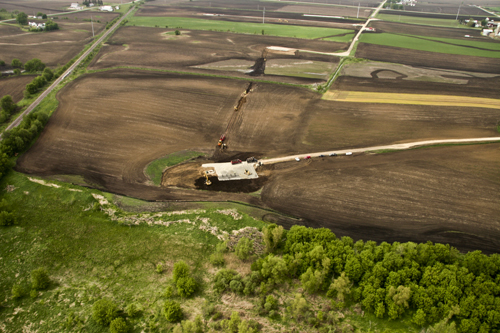 Turbine access road cutting diagonally across field in Glacier Hills project. May 2011
Turbine access road cutting diagonally across field in Glacier Hills project. May 2011
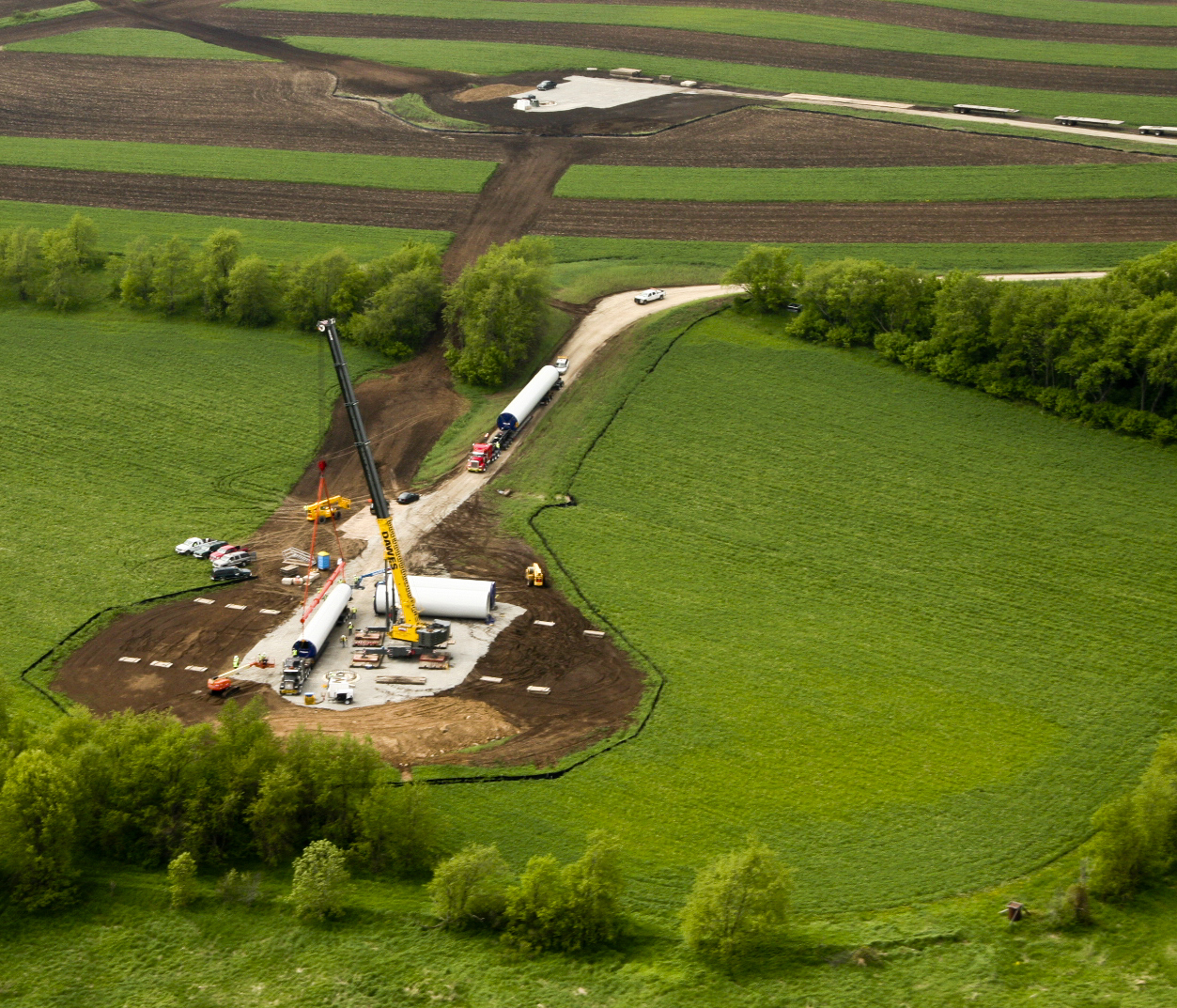
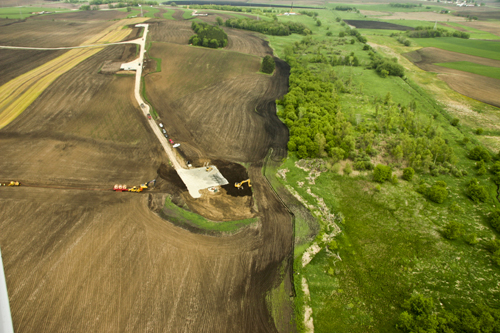
From One Wisconsin Farmer to Another:
This is an open letter to Wisconsin farmers who are considering signing a wind lease to host turbines on your land. Before you sign, I’d like to tell you about what happened to our family farm after we signed a contract with a wind developer.
In 2002, a wind developer approached my father about signing a lease agreement to place a MET tower on our land. My father was in his 70’s at the time. The developer did a good job of befriending him and gaining his trust.
He assured my father that the project wasn’t a done deal and was a long way off. They first had to put up the MET tower to measure the wind for awhile.
He told my father that if the project went forward there would be plenty of time to decide if we wanted to host turbines on our farm. There would be lots of details to work out and paperwork to sign well before the turbines would be built. The developer said my father could decide later on if he wanted to stay in the contract.
In 2003 the developer contacted us again. This time he wanted us to sign a contract to host turbines on our land. We were unsure about it, so we visited the closest wind project we knew of at the time. It was in Montfort, WI.
The Monfort project consists of 20 turbines that are about 300 feet tall and arranged in a straight line, taking up very little farmland with the turbine bases and access roads. The landowners seemed very satisfied with the turbines. But we were still unsure about making the commitment.
We were soon contacted again by the developer, and we told him we were undecided. Then he really started to put pressure on us to sign.
This was in March of 2004, a time of $1.60 corn and $1200 an acre land. It seemed worth it have to work around a couple of turbines for the extra cash. We were told the turbines would be in a straight line and only take up a little bit of land like the ones in Monfort.
And we were also told that we were the ones holding up the project. That all of our neighbors had signed, and we were the last hold-outs. It persuaded us.
What we didn’t know then was the developer was not being truthful. We were not the ‘last hold-out’ at all. In later discussions with our neighbors we found out that in fact we were the very first farmers to sign up. I have since found out this kind of falsehood is a common tactic of wind developers.
My father read through the contract. He said he thought it was ok. I briefly skimmed through it, found the language confusing, but trusted my father's judgment. We didn’t hire a lawyer to read it through with us. We didn’t feel the need to. The developer had explained what was in it.
The wind contract and easement on our farm was for 20 years. By then my dad was 75. He figured time was against him for dealing with this contract in the future so we agreed I should sign it. A few months later, my father died suddenly on Father's Day, June 20th, 2004
After that, we didn’t hear a whole lot about the wind farm for a couple years. There was talk that the project was dead. And then in 2007 we were told the developer sold the rights to the project. A Wisconsin utility bought it.
After that everything changed. The contract I signed had an option that allowed it to be extended for an additional 10 years. The utility used it.
The turbines planned for the project wouldn’t be like the ones in Monfort. They were going to be much larger, 400 feet tall. And there were going to be 90 of them.
They weren’t going to be in a straight row. They’d be sited in the spots the developer felt were best for his needs, including in middle of fields, with access roads sometimes cutting diagonally across good farm land. Landowners could have an opinion about turbine placement but they would not have final say as to where the turbines and access roads would be placed. It was all in the contract.
Nothing was the way we thought it was going to be. We didn't know how much land would be taken out of production by the access roads alone. And we didn't understand how much the wind company could do to our land because of what was in the contract..
In 2008 I had the first of many disputes with the utility, and soon realized that according to the contract I had little to no say about anything. This became painfully clear to me once the actual construction phase began in 2010 and the trucks and equipment came to our farm and started tearing up the field.
In October of 2010 a representative of the utility contacted me to ask if a pile of soil could be removed from my farm. It was near the base of one of the turbines they were putting on my land. I said no, that no soil is to be removed from my farm.
The rep said that the pile was actually my neighbor’s soil, that the company was storing it on my land with plans to move it to another property.
Shortly afterwards I noticed the pile of subsoil was gone.
In November of 2011 I saw several trucks loading up a second pile of soil on my land and watched them exiting down the road. I followed them and then called the Columbia County Sheriff. Reps from the company were called out. I wanted my soil back.
A few days later the rep admitted they couldn’t give it back to me because my soil was gone. It had been taken and already dispersed on someone else's land. I was offered 32 truck loads of soil from a stockpile they had. I was not guaranteed that the soil would be of the same quality and composition as the truck loads of soil they took from my farm.
I was informed by the lawyer for the utility that I had until April 30, 2011 to decide to take the soil. There would be no other offer. Take it or leave it.
I contacted the Public Service Commission for help. The PSC approved the terms of project and I believed the utility was violating those terms. The PSC responded by telling me they could do nothing because the issue involved a private contract between myself and the utility.
They told me my only option was to sue the utility.
My father and I both worked those fields. Watching the way they’ve been ripped apart would sicken any farmer. But what farmer has the time and money it would take to sue a Wisconsin utility?
By signing that contract I signed away the control of the family farm, and it’s the biggest regret I have ever experienced and will ever experience. I have only myself to blame for not paying close enough attention to what I was signing.
We had a peaceful community here before the developer showed up, but no more. Now it’s neighbor against neighbor, family members not speaking to one another and there is no ease in conversation like in the old days. Everyone is afraid to talk for fear the subject of the wind turbines will come up. The kind of life we enjoyed in our community is gone forever.
I spend a lot of sleepless nights wishing I could turn back the clock and apply what I've learned from this experience. Now corn and bean prices are up. The money from the turbines doesn't balance out our crop loss from land taken out of production. The kind of life we enjoyed on our family farm is gone forever too.
I would not sign that contract today. As I write this, the utility is putting up the towers all around us. In a few months the turbines will be turned on and we'll have noise and shadow flicker to deal with. If I have trouble with these things, too bad. I've signed away my right to complain. These are some of the many problems I knew nothing about when I signed onto the project.
If you are considering signing a wind lease, take the contract to a lawyer. Go over every detail. Find out exactly what can happen to your fields, find out all the developer will be allowed to do to your land. Go through that contract completely, and think hard before make your decision.
I can tell you from first hand experience, once you sign that contract, you will not have a chance to turn back.
Gary Steinich
Steinich Farms, Inc.
Cambria, WI
June, 2011
UPDATE: JUNE 5, 2011 Gary Steinich contacted Better Plan to let us know he and the utility have reached an agreement on his soil restoration.
EXTRA CREDIT READING:
It can be found on the PSC Docket for the Glacier HIlls project. [ #6634 CE 302]
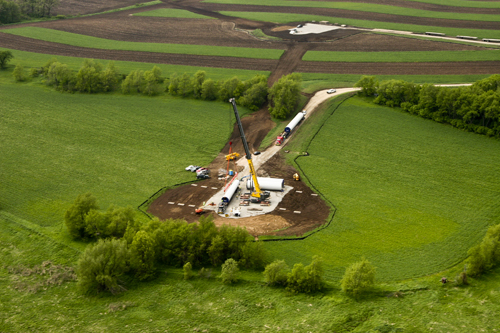
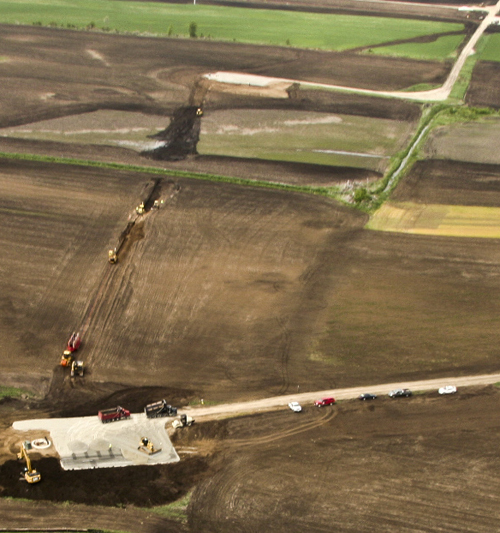
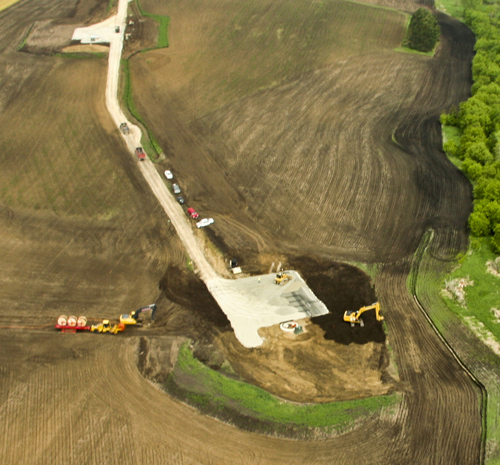
NEXT STORY: From Rock County, WI
SPRING VALLEY CONSIDERING BAN ON WIND TURBINES
SOURCE: The Janesville Gazette, gazettextra.com
June 4, 2011
By GINA DUWE
SPRING VALLEY TOWNSHIP — Town officials in Spring Valley are considering a new moratorium on wind turbines after the largest wind company in North America inquired about town wind ordinances.
The town board will discuss and likely vote on a moratorium at its Monday, June 13, meeting, Clerk Judy Albright said.
Spring Valley is among several area townships that wrote wind moratoriums while new rules to regulate wind projects less than 100-megawatts are decided at the state level.
Town officials discovered their previous moratorium expired Dec. 1 after Ted Weissman of NextEra Energy recently inquired about ordinances related to wind development and the process for placing a met tower.
A met tower gathers weather data to help wind developers determine if a site is good for development.
Weissman said he couldn’t comment but the company was looking at the area and hadn’t made any decisions. A company spokesman, however, said NextEra is not pursuing a met tower in Rock County.
Spokesman Steve Stengel said Weissman might have conducted some inquiries, but “we are not proposing it at this point,” he said. “What may or may not happen in the future (is) all speculation.”
NextEra owns and operates two wind farms in Wisconsin: 36 turbines at Butler Ridge Wind Energy Center in Dodge County and 20 turbines at Montfort Wind Energy Center in Iowa County.
Neighboring townships Magnolia and Union became possible sites for wind turbines a few years ago, and one met tower was placed in each town to gather data.
A spokeswoman for Acciona, the company that eyed those townships, said this week it is not pursuing “the early stage development project in Union and Magnolia. This enables (Acciona) to focus efforts and resources on other projects that are a better fit for their portfolio.”
Developers would be interested in hooking into the major transmission line that runs east-west through the northern part of Spring Valley, town officials said.
Smaller wind projects are permitted through local ordinances until lawmakers enact statewide rules.
Under state law, the Public Service Commission has to develop the rules, and a committee worked through most of last year to write the rules. When the rules were set to take effect in March, Republican lawmakers suspended them. It’s now up to legislators to approve new rules by May 2012 or the suspended rules would go into effect, a PSC spokesman said.
Republican Sen. Frank Lasee has proposed a bill that would add additional requirements to the PSC rules. The bill was referred to the Committee on Energy, Biotechnology and Consumer Protection, but no hearing is scheduled.
If you go
The town board will discuss and likely vote on a wind moratorium at its 7 p.m. meeting Monday, June 13, at the Orfordville Fire Department, 173 N. Wright St., Orfordville.
